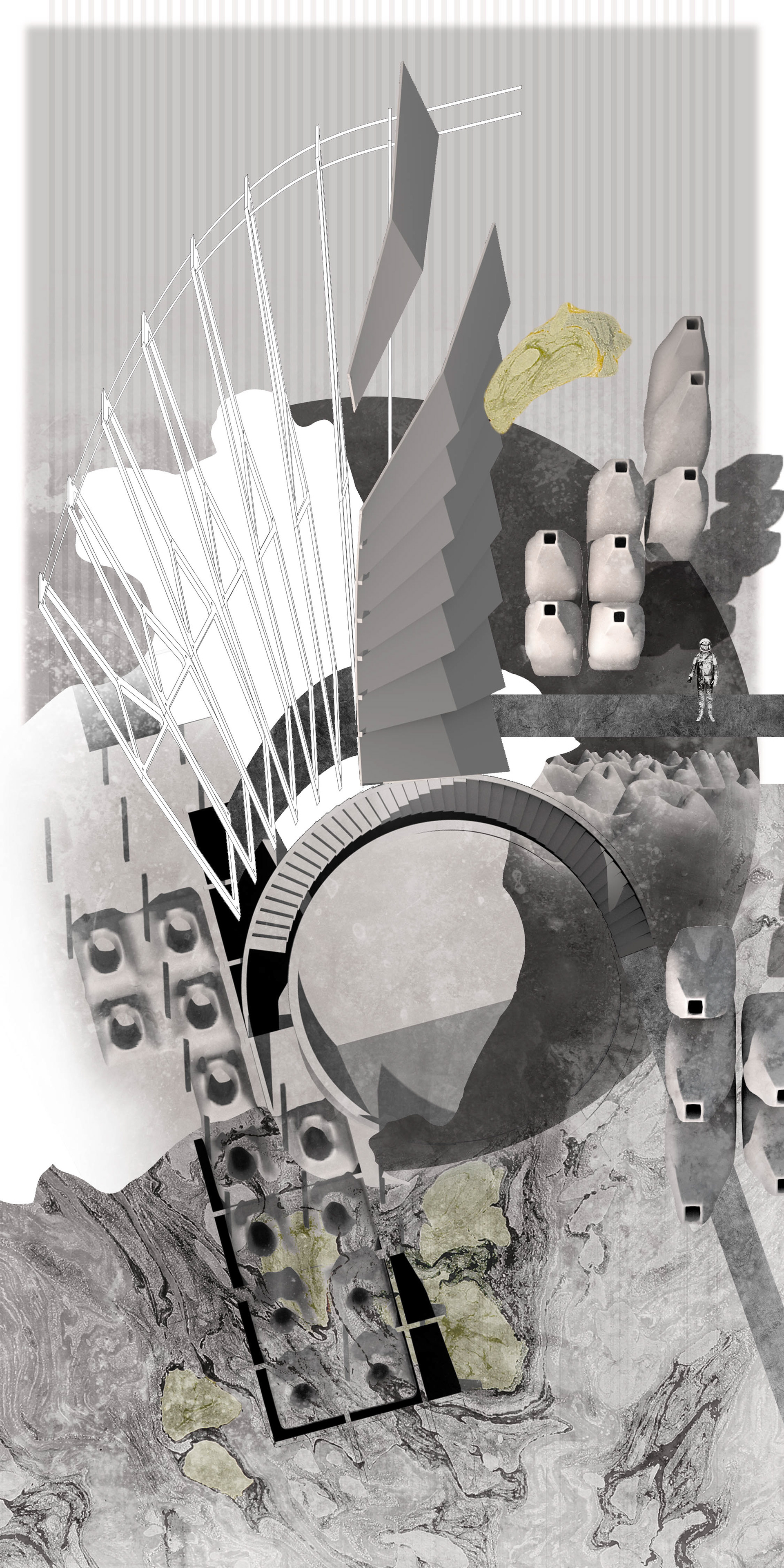︎︎
On Volatile Ground: The Divergent Monolith

Digging (a drawing)
Selected "Best in Category - Student Hand" in the 2015 Ken Roberts Memorial Delineation Competition hosted by AIA Dallas
I began this year indulging in what I referred to as our plastic relationship with the world, where and when, and who yields first. Then, the delineation of space, a disputatious affair of line and material – will they ever agree? I am now thinking about architecture as participatory and incomplete, and every expression interrogates the author, the configuration of material, and the imagined future. After this, I see architects as spatial orators: primitive forms in this hand and mystical ingenuity in the other, watching them collide.


This thesis interrogates representation as a generative model in the production of architecture. The work revels in the craft and impulsiveness of an available material palette, historical precedents, and an archive of fragments. The thesis does not intend to explore the capacity of drawing in the creation of form, but the latent, real, and speculative relationships related to inhabiting the indeterminacy of a drawing. Therefore, the work seeks to identity indexical attributes of an architectural proposition that shapes a spatiotemporal reality of incompleteness: an architecture that keeps the possibilities for settlement faint.
Simultaneous workings, seeking to construct the simultaneity of space: empirical inhabitation and documentation…The table is an architectural proposal that holds many. I believe this work positions architects as drawing characteristics from storytellers, cultural geographers, acupuncturists, and taxidermists: conspirators with a predilection of augmenting a collection of the petrified past.The temporal conclusion that I can draw at this moment is found not only in the work, but a list of aphorisms that I have been writing all year. In a way, through describing the impetus and outcome in these statements I have been able to construct a lens at which through to problematize and ask new questions.
[1] How do you excavate a drawing? For instance, we have an embodied knowledge of digging a hole, and inhabiting the hole we’ve dug, but also the pile left behind.
[2] I believe architecture to be characters: what does it mean disciplinarily to move away from an architecture that relies on definitions, and now is constructed of identities?
[3] Ideas have no typology. As architects, what role does context play in determining the hierarchy of the realities we employ: for example when and where does the reality of the drawing supersede the realities of site, program, and formal efficiency.
Simultaneous workings, seeking to construct the simultaneity of space: empirical inhabitation and documentation…The table is an architectural proposal that holds many. I believe this work positions architects as drawing characteristics from storytellers, cultural geographers, acupuncturists, and taxidermists: conspirators with a predilection of augmenting a collection of the petrified past.The temporal conclusion that I can draw at this moment is found not only in the work, but a list of aphorisms that I have been writing all year. In a way, through describing the impetus and outcome in these statements I have been able to construct a lens at which through to problematize and ask new questions.
[1] How do you excavate a drawing? For instance, we have an embodied knowledge of digging a hole, and inhabiting the hole we’ve dug, but also the pile left behind.
[2] I believe architecture to be characters: what does it mean disciplinarily to move away from an architecture that relies on definitions, and now is constructed of identities?
[3] Ideas have no typology. As architects, what role does context play in determining the hierarchy of the realities we employ: for example when and where does the reality of the drawing supersede the realities of site, program, and formal efficiency.



Devil’s Slide is a coastal promontory near San Francisco. Historically, the land has served as strategic defense of the West Coast of the United States in the height of World War II. Today, it is infamous for it’s steep cliffs and seemingly perpetual landslides. After decommission of the base stations that once punctuated the landscape, there has not been any sanctioned construction on the site. The proposal seeks to explore the architecture, as building, as a means to define a fixed temporality. A reality that exists between the drawing and material configuration as a way to “augment, qualify, and negate conditions.” The timely fragments of war once served to protect and allow for projection outward; a vigil held for the horizon. The Observation Center attempts to creatively invert the infrastructure of drawing and spatiality simultaneously: drawing thickened, space thinned.
The lone dweller, a park ranger, has been tasked with the collection of geological and synthetic artifacts before they fall into the sea. As the land falls away, the ranger retreats, digs, and waits. The ranger values the latency of qualitative information more than analytic domination. The ranger serves as the nexus for defining spatial sequences: cyclical and intermittent. These include the curating and maintenance of artifacts, monitoring and repair of the unstable ground (drawing), interacting with tourists, hikers, and occasional campers, general maintenance, particularly graffiti removal (or preservation), tending to public and private garden spaces. The Ranger has been extended the freedom to curate his/her own private dwelling through personal choice.
The proposition is hypothetical and is an exploration of the practice and influence of representation.










- Drawing [in] Space
- Devil’s Slide Observatory, 1
- Devil’s Slide Observatory, 2-7
- In Search of a Stable Center
- Devil’s Slide Observatory, 8
- Works from Japan
- 37 Aphorisms
- Retreating Model
- Digging, Excavating, Piling
- Six Books from Japan
- Degree Project Books
- Early Drawings
- Relics
- Constructs, 1, 2, 3
- Relief Drawing
- Indexical Construct, 1, 2
- Indexical Construct, 3,4
- Indexical Construct, 5
- Haikus and Tile from Japan


© 2024 Matthew Bohne — Brooklyn, New York